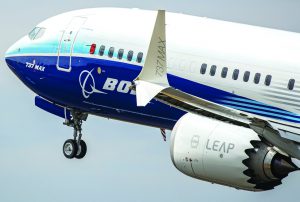BLOOMBERG
Boeing Co is moving ahead with plans to hike output of its cash-cow 737 jetliner while dealing with the ripple effects from a new production flaw uncovered by one of its largest suppliers. The US planemaker isn’t altering the schedule for its 737 suppliers, including rate increases, Chief Executive Officer Dave Calhoun said at a virtual gathering of shareholders. Bloomberg reported earlier that Boeing intends to hike output of its workhorse narrowbody jet by 23% by midyear.
Boeing understands the extent of the work it faces to repair affected airplanes in production and storage, Calhoun said, while providing few new details about the 737 disruption that the company disclosed recently.
He told investors that the latest operations stumble wouldn’t stop Boeing from reaching its annual target of churning out $10 billion in free cash by mid-decade. The aviation titan is making “meaningful progress†on its recovery from years of crises and operational lapses, Calhoun said, adding: “We have the right team, right products, right services and right strategy. We just have to execute.â€
Boeing shares rose as much as 1.8% in New York trading in response to Calhoun’s remarks, erasing an earlier decline. The manufacturer was the best performer among the 30-member Dow Jones Industrial Average.
Still, some shareholders signaled impatience with a string of quality lapses that have led to losses on defense contracts, and hiccups in deliveries for marquee commercial jets like the 737 Max and 787 Dreamliner.
“Here we are a year later and the company still can’t seem to get out of its own way,†Paul Chesser, a director with the National Legal and Policy Center, said at the annual general meeting. Returning the 737 Max to pre-grounding production levels is crucial if Boeing is to resume being the prodigious cash generator that made it a darling of Wall Street last decade. The planemaker had seemed to be turning itself around after delivering more jets in the first quarter than rival Airbus SE for the first time nearly five years.
The revelation of an issue affecting hundreds of 737 Max built since 2019 clipped about $7 billion from Boeing’s market value in trading the next day. For investors, it was a reminder that the companies supporting Boeing and Airbus factories are grappling with their own quality and labour issues, adding risk to plans to rapidly crank up aircraft production.
Improper Process
The problem centres on Spirit AeroSystems Holdings Inc, where workers didn’t follow the proper manufacturing processes on fittings used to attach a 737 tail to its aft fuselage, Cai Von Rumohr, an analyst with TD Cowen, wrote in a note. Another supplier of the parts correctly followed the standard procedure, a reason why not every 737 Max or P-8 maritime patrol plane faces repairs.
Von Rumohr estimates that between 550 and 800 aircraft will need to be inspected and repaired. Boeing and Spirit are expected to provide more detail on the cost and scope of work required when they report quarterly earnings in the coming weeks.
“Ultimately, Boeing’s worst enemy continues to be themselves,†Ron Epstein, an analyst with Bank of America, wrote in an April 17 report. “Each step Boeing’s taken towards improvement seems to be almost in lockstep with an executional misstep.â€
 The Gulf Time Newspaper One of the finest business newspapers in the UAE brought to you by our professional writers and editors.
The Gulf Time Newspaper One of the finest business newspapers in the UAE brought to you by our professional writers and editors.
